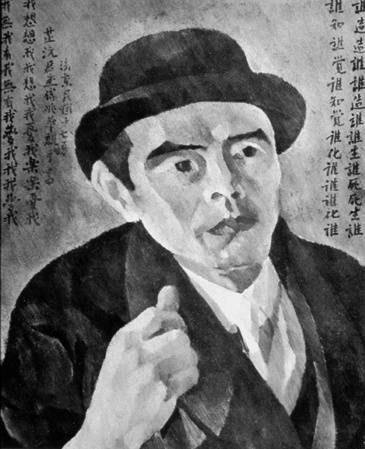Yun Gee's Art: Difference between revisions
No edit summary |
m (1 revision(s)) |
(No difference)
| |
Revision as of 13:55, 7 October 2007
Chinese Man in Hat by Yun Gee shows the mix of styles that Gee employed.
With Gee's extant paintings, we might be able to glimpse something of the uncomfortable or at least unstable vision of a radical Asian-American cultural sensibility. On the one hand, the new Chinatown inspires fascination and self-sufficiency; on the other, self-consciousness and loss. At one end of town, the streets insist on Chinatown's own fullness and offer the possibility of delight; at the other, they require a sense of the quarter's isolation and distance. At Chinatown's heart, the brilliant corners and elegant lamps do not require any singular bodily awareness on the part of the stroller but promise a collective fantasy of plenitude; at the edge, the fantasy disappears, and a simple comparison with the space beyond quickly demands an imaginative surrogate. There does not seem to be a resolution between the two, nor, worse, an alternative.
The closest Gee came to placing the two attitudes together in one painting occurred in a small oil on paper board, entitled Chinese Man in Hat (fig. 6). The painting may very well be a portrait of a Club member, since the painters' subjects tended to be so insular. Running halfway down either side of the central figure is Chinese script. On the left, a repetition of characters suggests a series of claims for some unknown "I": "to have," "not to have," "to have," "not to have." The object of possession is spelled out in the shortest line: "the republic." On the right, another set of characters proposes a series of actions for some unknown "who": "to be born," "to feel," "to know," "to create," "to transform," "to die." The words are repeated over and again, as if they are the product of some hallucinatory dream state and as if they condense a man's life into a succinct sequence, repeated without break. The two halves of the painting are like a divided self, the one half a directed and possessive "I," the other half a resigned and disembodied "who." The central figure points to himself, as if to lay claim to the dissonant set of characterizations and their contradiction.
--by Anthony W. Lee, excerpted from Reclaiming San Francisco: History, Politics, Culture, A City Lights Anthology
Contributors to this page include:
Lee - Publisher or Photographer
Lee,Anthony,W. - Writer

